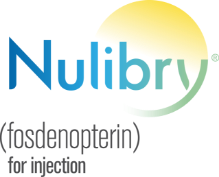
This product information is intended for US audiences only.
For residents outside the US, click here for more information on early access to Nulibry.
Nulibry® (fosdenopterin) for injection, for intravenous use
What is NULIBRY?
NULIBRY is indicated to reduce the risk of mortality in patients with molybdenum cofactor deficiency (MoCD) Type A.1 It is a cyclic pyranopterin monophosphate (cPMP) that replaces a critical component the body needs to make molybdenum cofactor (MoCo). To learn more, visit nulibry.com.
What is MoCD Type A?
MoCD Type A is a rare and devastating inborn error of metabolism (IEM) that presents shortly after birth,2,3 progresses rapidly, causes irreparable damage, and often leads to an early death (median survival age is 4 years).1-5 A missed diagnosis can mean a missed opportunity to fight this devastating disease.
You are encouraged to report negative side effects of prescription drugs to the FDA. Visit www.fda.gov/medwatch, or call 1-800-FDA-1088.
Please see full Prescribing Information for NULIBRY.
INDICATION
NULIBRY is indicated to reduce the risk of mortality in patients with molybdenum cofactor deficiency (MoCD) Type A.
IMPORTANT SAFETY INFORMATION
WARNINGS AND PRECAUTIONS
Potential for Photosensitivity
NULIBRY can make the patient oversensitive to sunlight. NULIBRY-treated patients or their caregivers are advised to avoid or minimize patient exposure to sunlight and artificial UV light and adopt precautionary measures when exposed to the sun, including wearing protective clothing and sunglasses, and use broad-spectrum sunscreen with high SPF in patients 6 months of age and older. If photosensitivity occurs, caregivers/patients are advised to seek medical attention immediately and consider a dermatological evaluation.
SIDE EFFECTS
The most common side effects in NULIBRY-treated patients were infusion catheter–related complications, pyrexia (fever), viral infection, pneumonia, otitis media (ear infection), vomiting, cough/sneezing, viral upper respiratory infection (common cold/flu-like infection), gastroenteritis (stomach flu-like symptoms), diarrhea, and bacteremia (bacteria in the blood). Side effects for rcPMP-treated patients were similar to the NULIBRY-treated patients.
PATIENT COUNSELING INFORMATION
Please read the FDA-approved NULIBRY Prescribing Information and Instructions for Use and follow the instructions on how to prepare and administer NULIBRY.
NULIBRY has a potential for photosensitivity; see Warnings and Precautions. Seek medical attention immediately if the patient develops a rash or if they notice symptoms of photosensitivity reactions (redness, burning sensation of the skin, blisters).
You are encouraged to report negative side effects of prescription drugs to the FDA. Visit www.fda.gov/medwatch, or call 1-800-FDA-1088.
References: 1. NULIBRY [prescribing information]. https://dailymed.nlm.nih.gov/dailymed/drugInfo.cfm?setid=4f67cc4e-84ed-4f4e-a5d9-6ffbfb84eddd. 2. Mechler K, et al. Genet Med. 2015;17(12):965-970. 3. Veldman A, et al. Pediatrics. 2010;125(5):e1249-e1254. 4. Durmaz MS, et al. Radiol Case Rep. 2018;13(3):592-595. 5. National Institutes of Health. https://ghr.nlm.nih.gov/condition/molybdenum-cofactor-deficiency.
PM-ST-22001.01



